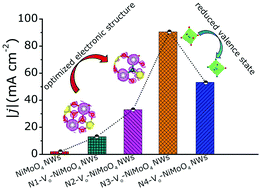Activation of defective nickel molybdate nanowires for enhanced alkaline electrochemical hydrogen evolution†
Abstract
Designing highly-efficient and cost-effective electrocatalysts for the hydrogen evolution reaction (HER) in an alkaline solution is more complex and sluggish than for an acidic one. Herein, we report a controllable N-doping strategy to synthesize a series of N-doped porous metallic NiMoO4 nanowires with concomitant oxygen vacancy defects (N-Vo-NiMoO4 NWs) for promoting the alkaline HER ability and durability. Both experimental and theoretical results demonstrate that the doped-N at NiO6 octahedral sites and the abundant oxygen vacancy defects confined in N-Vo-NiMoO4 NWs with modified electronic arrangement could enhance the metallic conductivity, affect the surface areas, and lower the adsorption energy of hydrogen, resulting in an increased HER property. However, the excess doped-N leads to an opposite effect due to the reduced valence state of Ni centres. Therefore, alkaline HER ability of N-Vo-NiMoO4 NWs exhibits a volcano-like trend vs. the nitrogen content, with N3-Vo-NiMoO4 NWs being the best one. As a result, the N3-Vo-NiMoO4 NWs show nearly zero onset overpotential, an overpotential of 55 mV at 10 mA cm−2, and a Tafel slope of only 38 mV dec−1 in 1.0 M KOH, which are superior to those of state-of-the-art platinum-free electrocatalysts.

- This article is part of the themed collection: 2018 Nanoscale HOT Article Collection


 Please wait while we load your content...
Please wait while we load your content...